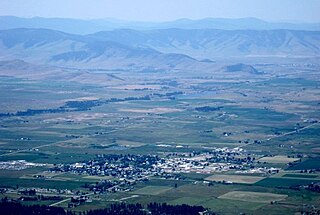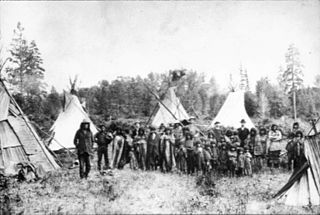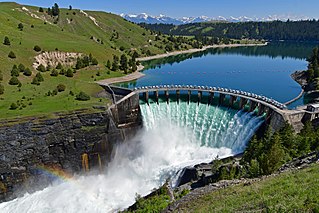
Charlo is an unincorporated community and census-designated place (CDP) in Lake County, Montana, United States. The population was 379 at the 2010 census, down from 439 in 2000. The 2018 population estimate was 320.

Finley Point is a census-designated place (CDP) in Lake County, Montana, United States. As of the 2010 census the population was 480.

Ravalli is an unincorporated community and census-designated place (CDP) in Lake County, Montana, United States. The population was 76 at the 2010 census, down from 119 in 2000. At one time Charlie Allard, the country's leading expert on breeding bison, owned the country's largest herd of buffalo in Ravalli.

Turtle Lake is a census-designated place (CDP) in Lake County, Montana, United States. The population was 209 at the 2010 census.

Florence is a census-designated place (CDP) in Ravalli County, Montana, United States. The population was 821 at the 2020 census.

Pablo is a census-designated place (CDP) in Lake County, Montana, United States. The population was 2,254 at the 2010 census, up from 1,814 in 2000. It is the home of Salish Kootenai College and the seat of government of the Flathead Indian Reservation.

Ronan is a city in Lake County, Montana, United States. It lies on the Flathead Indian Reservation, approximately 12 miles south of Flathead Lake in the northwestern part of the state. The population was 1,955 at the 2020 census.

The Flathead Indian Reservation, located in western Montana on the Flathead River, is home to the Bitterroot Salish, Kootenai, and Pend d'Oreilles tribes – also known as the Confederated Salish and Kootenai Tribes of the Flathead Nation. The reservation was created through the July 16, 1855, Treaty of Hellgate.

The Confederated Salish and Kootenai Tribes of the Flathead Reservation are a federally recognized tribe in the U.S. state of Montana. The government includes members of several Bitterroot Salish, Kootenai and Pend d'Oreilles tribes and is centered on the Flathead Indian Reservation.

The Bitterroot Salish are a Salish-speaking group of Native Americans, and one of three tribes of the Confederated Salish and Kootenai Tribes of the Flathead Nation in Montana. The Flathead Reservation is home to the Kootenai and Pend d'Oreilles tribes also. Bitterroot Salish or Flathead originally lived in an area west of Billings, Montana extending to the continental divide in the west and south of Great Falls, Montana extending to the Montana-Wyoming border. From there they later moved west into the Bitterroot Valley. By request, a Catholic mission was built here in 1841. In 1891 they were forcibly moved to the Flathead Reservation.

The Kutenai, also known as the Ktunaxa, Ksanka, Kootenay and Kootenai, are an indigenous people of Canada and the United States. Kutenai bands live in southeastern British Columbia, northern Idaho, and western Montana. The Kutenai language is a language isolate, thus unrelated to the languages of neighboring peoples or any other known language.

The Pend d'Oreille, also known as the Kalispel, are Indigenous peoples of the Northwest Plateau. Today many of them live in Montana and eastern Washington. The Kalispel peoples referred to their primary tribal range as Kaniksu.

Flathead Lake is a large natural lake in northwest Montana.

The Kerr Dam, officially known since 2015 as the Seli’š Ksanka Qlispe’ Dam, is a concrete gravity-arch dam located at river mile 72 of the Flathead River. Built in 1938, it raises the level and increases the size of Flathead Lake near Polson, Montana. The dam was designed to generate hydroelectricity but also serves recreational and irrigation uses.

Salish Kootenai College (SKC) is a Private tribal land-grant community college in Pablo, Montana. It serves the Bitterroot Salish, Kootenai, and Pend d'Oreilles tribes. SKC's main campus is on the Flathead Reservation. There are three satellite locations in eastern Washington state, in Colville, Spokane, and Wellpinit. Approximately 1,207 students attend SKC. Although enrollment is not limited to Native American students, SKC's primary function is to serve the needs of Native American people.

The Salish Sea is a marginal sea of the Pacific Ocean located in the Canadian province of British Columbia and the U.S. state of Washington. It includes the Strait of Georgia, Strait of Juan de Fuca, Puget Sound, and an intricate network of connecting channels and adjoining waterways.

Lolo Hot Springs is an unincorporated community in Missoula County, Montana, United States. It is centered on a commercial hot springs and contains a hotel and restaurant. Lolo Hot Springs is the westernmost settlement along U.S. Highway 12 in Montana.
Kicking Horse Dam is a dam in Lake County, Montana.
Charlos Heights or Charlo's Heights is a census-designated place (CDP) in Ravalli County, Montana, United States. The population was 120 at the 2010 census.

The College of Science is a college within the University of Notre Dame. The Dean of the College of Science is Santiago Schnell, appointed Sept 1st, 2021.




















